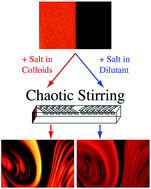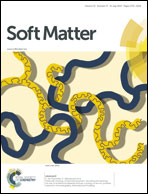How a “pinch of salt” can tune chaotic mixing of colloidal suspensions†
Abstract
Efficient mixing of colloids, particles or molecules is a central issue in many processes. It results from the complex interplay between flow deformations and molecular diffusion, which is generally assumed to control the homogenization processes. In this work we demonstrate on the contrary that despite fixed flow and self-diffusion conditions, the chaotic mixing of colloidal suspensions can be either boosted or inhibited by the sole addition of a trace amount of salt as a co-mixing species. Indeed, this shows that local saline gradients can trigger a chemically driven transport phenomenon, diffusiophoresis, which controls the rate and direction of molecular transport far more efficiently than the usual Brownian diffusion. A simple model combining the elementary ingredients of chaotic mixing with diffusiophoretic transport of the colloids allows rationalization of our observations and highlights how small-scale out-of-equilibrium transport bridges to mixing at much larger scales in a very effective way. Considering chaotic mixing as a prototypal building block for turbulent mixing suggests that these phenomena, occurring whenever the chemical environment is inhomogeneous, might bring interesting perspectives from micro-systems to large-scale situations, with examples ranging from ecosystems to industrial contexts.


 Please wait while we load your content...
Please wait while we load your content...